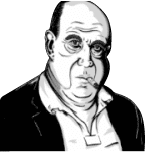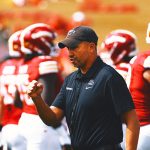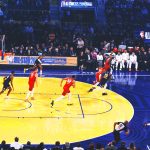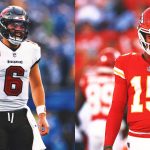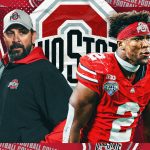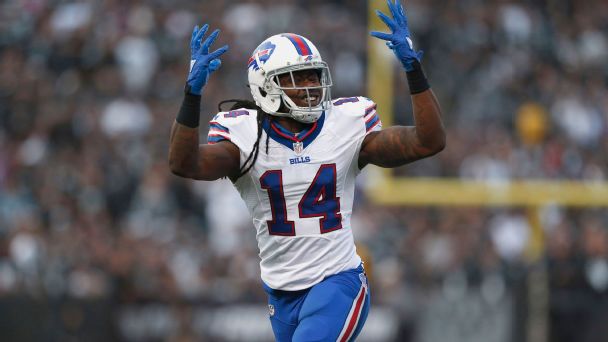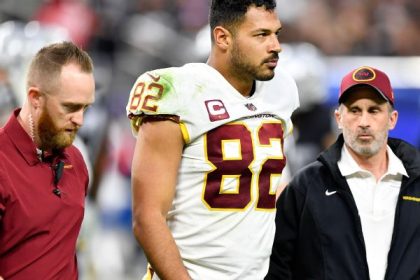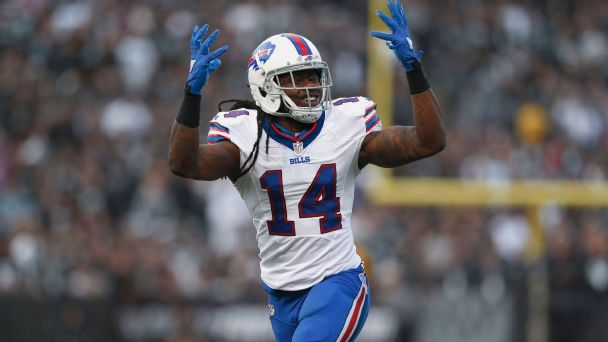
Trading up in the NFL draft for a non-quarterback is a temptation general managers should almost always resist. Like candy while on a diet or an NBA midrange 2, passing on immediate satisfaction will lead to better long-term results.
The value of trading down — and not trading up — has been an enduring refrain of analytics disciples ever since economists Cade Massey and Richard Thaler wrote their original paper on overconfidence and market efficiency (or lack thereof) in the NFL draft more than 15 years ago. In that analysis the economists found, for example, that the probability a first-round player starts more games than the next-selected player at his position is just 58% — and only 53% across the entire draft. Still, even as other quantitative analysis conclusions have achieved major NFL buy-in — from fourth-down attempts to pass-first philosophies to the value of running backs — GMs continue to pay expensive prices to land specific prospects they covet in the draft.
It will surely happen again in 2024. And when it does, we will hear a variety of arguments rationalizing those decisions — to trade up or to not trade down — from GMs themselves and fans of the trade-up teams, high off the thrill of the (maybe) better prospect acquired. Today we’re looking at seven clichés used to justify draft trade-ups, so you can steel yourself ahead of their arrival once the draft begins on April 25.
All of these arguments are in reference to teams that are trading up for a non-quarterback — QB deals are another category, because the success upside vastly outpaces the upside of a trade-up for any other position. So let’s dive in.
More NFL draft coverage:
Latest mock drafts | Scouting reports
Try the new ESPN mock draft simulator

‘It was even on the Jimmy Johnson chart’
The real-life example: In 2022, the Chiefs traded pick Nos. 29, 94 and 121 to the Patriots to move up to No. 21 and select cornerback Trent McDuffie. The deal was virtually even on the Johnson chart, with the Chiefs surrendering 816 points to the Patriots’ 800.
But the Johnson chart doesn’t actually reflect the expected production of players by draft pick. It was created in the 1990s to illustrate what the draft pick trade market had been (as opposed to should be). Despite that important distinction and three decades passing, the chart is somehow still a guidepost for modern trades.
While there have been many different attempts to quantify the true value of draft picks into a chart based on actual player performance, they all (as far as I am aware) have come to the same conclusion — the Johnson chart is wildly overconfident.
By ESPN’s AV-based draft chart, the Chiefs paid a 56% premium in this deal: In other words, they gave up the equivalent of an extra late second-round or early third-round pick. Note that we’re not even discussing surplus value — the value of the player’s performance relative to their rookie contract — which generally makes the draft curve less steep (as two of the five linked charts above incorporate).
I know what you’re thinking: Are you really criticizing a trade-up for McDuffie, a future first-team All-Pro? Yes, I’m criticizing the process. If I picked out only examples of trade-ups that failed, you shouldn’t trust me! There are plenty of examples of trade-ups that did work out — McDuffie being one. It’s just that history — via trade charts based on player production — shows that more often they don’t. And it’s either extremely hard or impossible to predict when the wins will happen.
There also is a small chance the targeted player in a trade would have made it to the trade-up team had it stayed put. While it was unlikely in this instance — ESPN’s Draft Day Predictor gave McDuffie just an 11% chance to reach pick No. 29 entering round one — that factor still should play a role in a team’s decision to move up in the draft.
‘Trading up was worth it to get our guy‘
The real-life example: In 2011, the Saints dealt a 2012 first-round pick to move up from No. 56 back into the first-round at No. 28 to select running back Mark Ingram.
“I’ll be honest with you, we’re sitting there after our [first] pick, and Sean [Payton] and I are sitting there and talking and it’s like, ‘Hey, how can we get Mark Ingram?’ So we started making some calls,” Saints GM Mickey Loomis said in his news conference after the selection.
Clearly, the Saints badly wanted Ingram. But conviction about the player shouldn’t excuse the expected value tossed aside to acquire him.
The problem with the “our guy” argument is that basically every trade-up team in the past also thought they were getting “their guy” — that’s why they traded up! If the sense of confidence teams feel about their trade-up targets was valuable, the results should indicate it. Those trades ought to pan out. But on average, they don’t.
There were 140 trade-ups for non-quarterbacks in the first three rounds from 2013 to 2022. In terms of total Approximate Value (AV) accumulated through the 2022 season, 85 of those deals were “won” by the trade-down team, 49 were “won” by the trade-up team and six were a tie (see corresponding inline chart).
This trade was also a (somewhat narrow) AV loss. The picks New Orleans dealt for Ingram eventually turned into running back Shane Vereen and guard Kevin Zeitler (who has 181 starts and counting and is coming off a Pro Bowl selection in 2023).
‘He’s the missing piece’
The real-life example: In 2014, the Bills sent the No. 9 overall pick along with 2015 first- and fourth-rounders to move up to No. 4 to take wide receiver Sammy Watkins. The team’s playoff drought (which had been going since 1999) was on their mind when making the trade. “The high cost of not making the playoffs is something we weighed in and we thought this guy was going to get us to the playoffs,” then-Bills GM Doug Whaley said.
While Buffalo increased its expected value from this trade in 2014, over the long haul this was one of the largest overpays for a first-round non-QB over the past 20 years, according to ESPN’s draft pick valuations. Placing so many resources in a single player ignored the fact that those resources, separately, were likely to be worth more to Buffalo’s playoff chances over the next few seasons.
I want to stress I’m not judging this for the result — this isn’t about Watkins not panning out — but to illustrate how the draft’s talent drop-off is flatter than it appears. That year players still on the board where the Bills were originally scheduled to pick at No. 9 included Aaron Donald, Odell Beckham Jr., Zack Martin, Brandin Cooks and C.J. Mosley. The Bills gave up a first-round pick to move from No. 9 to No. 4 when, that year, players picked at Nos. 11-20 ended up on par or better than the players that were selected at Nos. 1-10.
‘If he hits, it will all be worth it’
The real-life example: In 2023, the Texans traded Nos. 12 and 33, a 2024 first-round pick and a 2024 third-round pick to move up to No. 3 to select edge rusher Will Anderson Jr. (and No. 105). According to ESPN’s trade value chart, Houston paid about a 70% tax to make this move, the second-largest overpay for a first-round non-QB since 2004 (only behind the Julio Jones trade-up in 2011). Even the Jimmy Johnson chart had this trade as an overpay.
“We’re certainly not worried about what the points are and what the trade chart says,” Texans GM Nick Caserio said at the time. “I mean, it doesn’t really mean anything. So the trade was really driven more by, this is a player we thought would bring a lot of value to our team. So that’s why we went ahead and did it.”
Let’s imagine Caserio had been in a casino instead of the war room. He’s sitting at a blackjack table with a hard 13 against the dealer’s 5. Basic strategy calls for him to stand, but Caserio ignores the chart and hits. He may still win the hand, but no one would argue that the process was sound or justifies that hitting was the correct move. That analogy is not too dissimilar to what Caserio actually did.
While it’s true that the odds in the draft aren’t as well-known as they are in blackjack — perhaps Houston might have felt Anderson was a much, much better prospect than the typical No. 3 overall pick — Caserio bucked past evidence when he made that deal. Usually, that’s a losing proposition, as was the case for trade-ups for Cordarrelle Patterson in 2013, Watkins in 2014, Marcus Davenport in 2018 and Jaylen Waddle in 2021 — even though all four of those trades required less of a premium than the Anderson deal.
‘We had extra picks’
The real-life example: In 2019, the Steelers traded picks Nos. 20 and 52 and a 2020 third-round pick to the Broncos for pick No. 10 — which they used to select linebacker Devin Bush.
“We said under no circumstances we would go into tomorrow (Day 2) with less than two picks,” then-Steelers GM Kevin Colbert said after making the deal. But the Steelers had an extra early third-round pick from their Antonio Brown trade. “Without that trade, we would not have made this trade today,” Colbert said. “I feel comfortable in saying that because we wouldn’t have had enough picks to do it.”
He also noted the team was more comfortable giving up a third-round pick in 2020 because they would likely receive a third-round compensatory pick for losing Le’Veon Bell in free agency.
The problem with that logic, from my perspective, is that extra draft picks are still draft picks. The fact that they weren’t your original selections does not make them worth less.
The Steelers made a pricey trade-up with a 64% premium, throwing away the equivalent of a fringe first-round pick if we don’t discount the future pick (and a second-round pick even if we do). Pittsburgh had a little surplus of picks, but by trading up inefficiently it let someone else reap the reward.
‘We only gave up future picks’
The real-life example: In 2022 the Saints wanted a second first-round pick, so they dealt picks Nos. 18, 101 and 237; a 2023 first-round pick; and a 2024 second-round pick in exchange for picks Nos. 16, 19 and 194.
It doesn’t take a math wizard to figure this one out. In order to move a first-round pick forward in time from 2023 to 2022, the Saints lit a second-round pick on fire and moved down from No. 101 to No. 194.
I don’t know what to say about that except that eventually the future … becomes the present? NFL teams heavily discount future picks and I’m not sure they should. There’s no inflation in draft capital, so there’s no inherent present value argument. Teams that are willing to have a bare-minimum level of patience are handsomely rewarded in the current NFL trade market.
Just like the Eagles in 2022, teams would be wise to take advantage of their opponents’ lack of patience.
‘If it doesn’t work, the GM won’t be here for the missing picks’
Buffalo GM Brandon Beane gave a candid answer at the NFL combine this year about trading up for Josh Allen in 2018.
“We got criticized a little bit for how much we gave up for Josh. And I’m like, well if he doesn’t work out I’m not going to be here anyway, and if he does work out nobody’s going to give a s—.”
That is pretty honest and I think that approach might be rational for Beane and his career. But if you’re the owner or a fan, that is not a great thing to hear! When the bill comes due, the owner and fans are still there. We can put aside the specifics of the trade — it was for a quarterback, which we’ve said is a different category — but that mentality and approach is not healthy for an organization.
More recently, Scott Fitterer’s trade-up for Bryce Young in 2023 offered similar asymmetric risk for him. Whether or not that played into the Panthers’ decision to trade up to No. 1 we don’t know, but when Young had a poor rookie season the Panthers fired Fitterer but the team — and new GM Dan Morgan — were left without star receiver DJ Moore or a first-round pick in 2024.
This naturally applies more to quarterback trades, and while it’s reasonable to pay and risk more in search of a QB, the GM’s job security playing into the decision-making isn’t ideal for the organization.

Does it ever make sense to trade up?
Yes, it can. To be clear, there is nothing inherently wrong with trading up: in an efficient market trading up, trading down and staying put should all be reasonable options. But because trade-ups are typically not efficient, the easiest way for a trade-up to be palatable is if it is well below market price (and thus close to a fair price).
Once you’re paying something close to a fair price, then lots of arguments can start to come back into play to justify a trade-up. Perhaps there’s a huge drop-off at a critical position of need after the player you’re targeting or a player has fallen a few spots too far.
One example comes to mind. In 2021, the Browns traded picks Nos. 59 and 89 for Nos. 52 and 113 in order to draft linebacker Jeremiah Owusu-Koramoah, paying a tiny premium equivalent to a seventh-round pick according to ESPN’s pick valuation model. It was not unreasonable to think that premium could have been offset by Owusu-Koramoah falling well beyond the first round, where he was expected to be selected.
